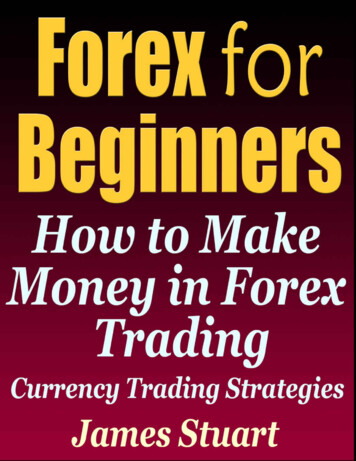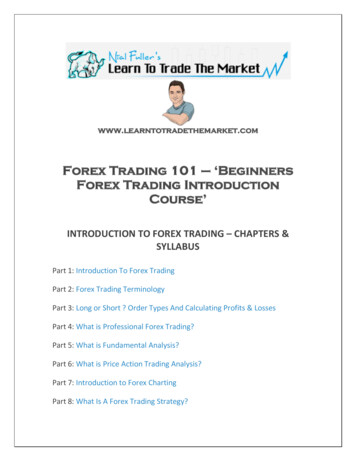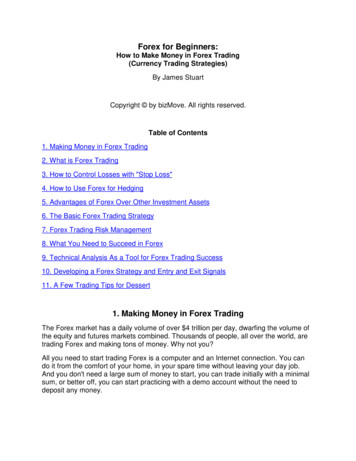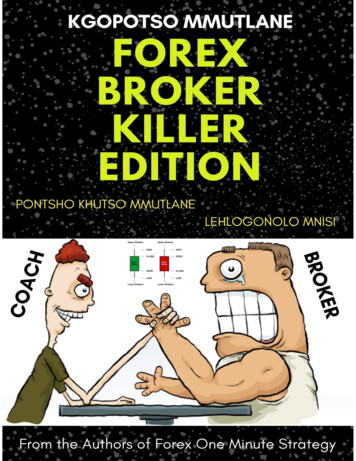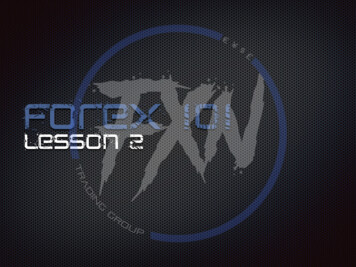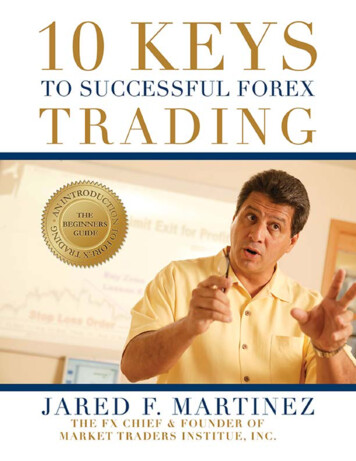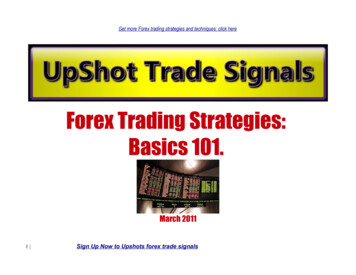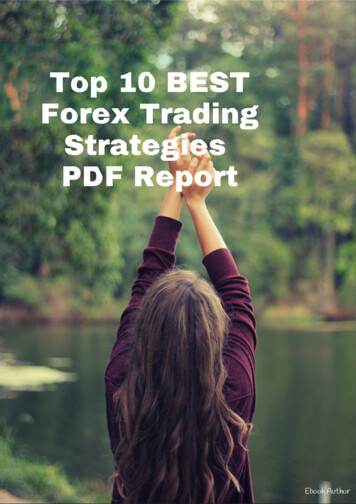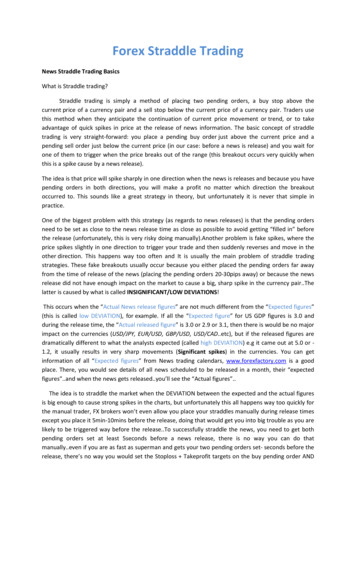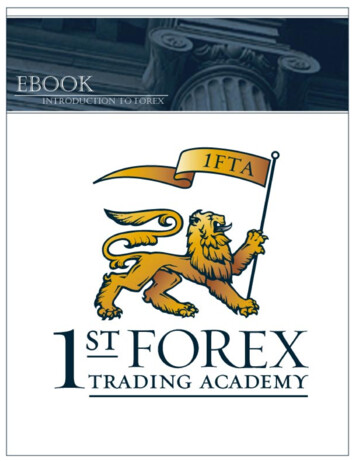
Transcription
DisclaimerTrading in the Forex market is a challenging opportunity where above average returns areavailable to educate and experienced investors who are willing to take above average risk.However, before deciding to participate in Forex trading, you should carefully consider yourinvestment objectives, level of experience and risk appetite. Most importantly, do not invest moneyyou cannot afford to lose.There is considerable exposure to risk in any foreign exchange transaction. Any transaction involvingcurrencies involves risks including, but not limited to, the potential for changing political and/oreconomic conditions that may substantially affect the price or liquidity of a currency.Moreover, the leveraged nature of FX trading means that any market movement will have anequally proportional effect on your deposited funds. This may work against you as well as for you.The possibility exists that you could sustain a total loss of initial margin funds and be requiredto deposit additional funds to maintain your position. If you fail to meet any margin call withinthe time prescribed, your position will be liquidated, without prior notice to you, and you will beresponsible for any resulting losses. Investors may lower their exposure to risk by employing riskreducing strategies such as “stop-loss” or “stop-limit” orders. 1st Forex Trading Academy 20042
TABLE OF CONTENTSIntroductionHow to read and interpret a weekly economic calendarHow to manage your riskFundamental AnalysisGlossaryFAQReading 1st Forex Trading Academy 200452335384253563
SUMMARY1st Forex Trading Academy’s FOREX trading course intends to provide to all of the studentsanalytical tools on the trading system and methodologies. In this respect, the purpose of thecourse is to provide an overview of the many strategies that are being used in this marketand to discuss the steps and tools that are needed in order to use these strategies successfully. TheAcademy firmly believe that the key to success rely on the application of the basis trading elementsand the discipline to stick to a strategy. Furthermore, the strategy chosen will have to meet yourobjectives and personality.1st Forex Trading Academy is a school with a true knowledge conscience and we understand thatthe objectives of all of our students are different and this is precisely why we are offering a coursethat will respect the capabilities of each individual in order to apply the mandate of the Academy.For many years, this market was reserved to people working in the financial business and we wantto share with the general public all the necessary information to access the trading market. 1st Forex Trading Academy 20044
IntroductionIntroductionDescription of the ForexThe Forex market, established in 1971, was created when floating exchange rates began tomaterialize. The Forex market is not centralized, like in currency futures or stock markets. Tradingoccurs over computers and telephones at thousands of locations worldwide.The Foreign Exchange market, commonly referred as FOREX, is where banks, investors andspeculators exchange one currency to another. The largest foreign exchange activity retainsthe spot exchange (i.e., immediate) between five major currencies: US Dollar, British Pound,Japanese Yen, Eurodollar and the Swiss Franc. It is also the largest financial market in the world.In comparison, the US stock market may trade 10 billion in one day, whereas the Forex marketwill trade up to 2 trillion in one single day. The Forex market is an opened 24 hours a day marketwhere the primary market for currencies is the 24-hour Interbank market. This market follows thesun around the world, moving from the major banking centres of the United States to Australiaand New Zealand to the Far East, to Europe and finally back to the Unites States.Until now, professional traders from major international commercial and investment banks havedominated the FX market. Other market participants range from large multinational corporations,global money managers, registered dealers, international money brokers, and futures and optionstraders, to private speculators.There are three main reasons to participate in the FX market. One is to facilitate an actualtransaction, whereby international corporations convert profits made in foreign currencies intotheir domestic currency. Corporate treasurers and money managers also enter the FX market inorder to hedge against unwanted exposure to future price movements in the currency market. Thethird and more popular reason is speculation for profit. In fact, today it is estimated that less than5% of all trading on the FX market is actually facilitating a true commercial transaction.The FX market is considered an Over The Counter (OTC) or ‘Interbank’ market, due to the factthat transactions are conducted between two counterparts over the telephone or via an electronicnetwork. Trading is not centralized on an exchange, as with the stock and futures markets. A true24-hour market, Forex trading begins each day in Sydney, and moves around the globe as thebusiness day begins in each financial center, first to Tokyo, London, and New York. Unlike anyother financial market, investors can respond to currency fluctuations caused by economic, socialand political events at the time they occur - day or night.History of the ForexMoney, in one form or another, has been used by man for centuries. At first it was mainly Gold or Silvercoins. Goods were traded against other goods or against gold. So, the price of gold became a referencepoint. But as the trading of goods grew between nations, moving quantities of gold around places tosettle payments of trade became cumbersome, risky and time consuming. Therefore, a system wassought by which the payment of trades could be settled in the seller’s local currency. But how much ofbuyer’s local currency should be equal to the seller’s local currency? 1st Forex Trading Academy 20045
IntroductionThe answer was simple. The strength of a country’s currency depended on the amount of goldreserves the country maintained. So, if country A’s gold reserves are double the gold reserves ofcountry B, country A’s currency will be twice in value when exchanged with the currency of countryB. This became to be known as The Gold Standard. Around 1880, The Gold Standard was acceptedand used worldwide.During the first WORLD WAR, in order to fulfill the enormous financing needs, paper money wascreated in quantities that far exceeded the gold reserves. The currencies lost their standard paritiesand caused a gross distortion in the country’s standing in terms of its foreign liabilities and assets.After the end of the second WORLD WAR the western allied powers attempted to solve the problemat the Bretton Woods Conference in New Hampshire in 1944. In the first three weeks of July 1944,delegates from 45 nations gathered at the United Nations Monetary and Financial Conference inBretton Woods, New Hampshire. The delegates met to discuss the postwar recovery of Europeas well as a number of monetary issues, such as unstable exchange rates and protectionist tradepolicies.During the 1930s, many of the world’s major economies had unstable currency exchange rates. Aswell, many nations used restrictive trade policies. In the early 1940s, the United States and GreatBritain developed proposals for the creation of new international financial institutions that wouldstabilize exchange rates and boost international trade. There was also a recognized need to organizea recovery of Europe in the hopes of avoiding the problems that arose after the First World War.The delegates at Bretton Woods reached an agreement known as the Bretton Woods Agreement toestablish a postwar international monetary system of convertible currencies, fixed exchange ratesand free trade. To facilitate these objectives, the agreement created two international institutions:the International Monetary Fund (IMF) and the International Bank for Reconstruction andDevelopment (the World Bank). The intention was to provide economic aid for reconstruction ofpostwar Europe. An initial loan of 250 million to France in 1947 was the World Bank’s first act.Under the Bretton Woods Exchange System, the currencies of participating nations could beconverted into the US dollar at a fixed rate, and foreign central banks could convert the US dollarinto gold at a fixed rate. In other words, the US dollar replaced the then dominant British Pound andthe parities of the world’s leading currencies were pegged against the US Dollar.The Bretton Woods Agreement was also aimed at preventing currency competition and promotingmonetary co-operation among nations. Under the Bretton Woods system, the IMF membercountries agreed to a system of exchange rates that could be adjusted within defined parities withthe US dollar or, with the agreement of the IMF, changed to correct a fundamental disequilibriumin the balance of payments. The per value system remained in use from 1946 until the early 1970s.The United States, under President Nixon, retaliated in 1971 by devaluing the dollar and forcingrealignment of currencies with the dollar. The leading European economies tried to counter the USmove by aligning their currencies in narrow band and then float collectively against the US dollar. 1st Forex Trading Academy 20046
IntroductionFortunately, this currency war did not last long and by the first half of the 1970’s leading worldeconomies gave up the fixed exchange rate system for good and floated their currencies in theopen market. The idea was to let the market decide the value of a given currency based on thedemand and supply of the currency and the economic health of the currency’s nation. This marketis popularly known as the International Monetary Market or IMM. This IMM is not a singleentity. It is the collection of all financial institutions that have any interest in foreign currencies, allover the world. Banks, Brokerages, Fund Managers, Government Central Banks and sometimesindividuals, are just a few examples.This is very much the present system of exchange of foreign currencies. Although the currency’svalue is dependent on the market forces, the central banks still try to keep their currency in apredefined (and highly confidential) fluctuation band. They accomplish this by taking one or moreof various steps.The International Trade Organization that had been planned in the Bretton Woods Agreementcould not be realized in the form initially envisaged - the US Congress would not endorse it.Instead, it was created later, in 1947, in the form of the General Agreement on Tariffs and Trade,which was signed by the US and 23 other countries including Canada. The GATT would laterbecome known as the World Trade Organization. In recent years, the two international institutionscreated at Bretton Woods the World Bank and the IMF have faced a major challenge in helpingdebtor nations to get back on stable financial footing.The EuromarketA major catalyst to the acceleration of Forex trading was the rapid development of the Eurodollarmarket; where US dollars are deposited in banks outside the US. Similarly, Euromarkets are thosewhere assets are deposited outside the currency of origin. The Eurodollar market first came intobeing in the 1950s when Russia’s oil revenue - all in dollars - was deposited outside the US infear of being frozen by US regulators. That gave rise to a vast offshore pool of dollars outside thecontrol of US authorities. The US government imposed laws to restrict dollar lending to foreigners.Euromarkets were particularly attractive because they had far less regulations and offered higheryields. From the late 1980s onwards, US companies began to borrow offshore, finding Euromarketsa beneficial center for holding excess liquidity, providing short-term loans and financing importsand exports.London was, and remains the principal offshore market. In the 1980s, it became the key centerin the Eurodollar market when British banks began lending dollars as an alternative to poundsin order to maintain their leading position in global finance. London’s convenient geographicallocation (operating during Asian and American markets) is also instrumental in preserving itsdominance in the Euromarket. 1st Forex Trading Academy 20047
IntroductionImportant dates in the Forex HistoryEarly 20th CenturyOnly in the 20th century paper money start regular circulation. This happened by force of legislation,the efforts of central banks to manage money supplies, and government control of gold supplies.Within a country, this fiat money is as good as any other form. Internationally, it is not. Internationaltrade has always demanded a money standard accepted everywhere.Gold and silver provided such a standard for centuries. An official Gold Standard regulated thevalue of money for about a century, prior to the start of World War I in 1914.1929The dollar has been perceived as more of a has-been, due to the Stock Market Crash and thesubsequent Great Depression.1930The Bank for International Settlements (BIS) was established in Basel, Switzerland. Its goals wereto oversee the financial efforts of the newly independent countries, along with providing monetaryrelief to countries with temporary balance of payments difficulties.1931The Great Depression, combined with the suspension of Gold Standard, created a serious diminutionin foreign exchange dealings.World War IIBefore World War II, currencies around the world were quoted against the British Pound. WorldWar II crashed the Pound. The only country unscarred by the war was the US. The US dollarbecame the prominent currency of the entire world.1944The United National Monetary and Financial Conference at Bretton Woods, New Hampshirediscussed the financial future of the post-war world. The major Western Industrialized nationsagreed to a «pegging» of the US Dollar, which in turn was pegged at 35.00 to the troy ounce ofgold. The future was designed to be stable, in part due to the tight governmental controls on currencyvalues. The US dollar became the world’s reserve currency.1957The European Economic Community was established. 1st Forex Trading Academy 20048
Introduction1967At the IMF meeting in Rio de Janeiro, the Special Drawing Rights (SDRs) were created. SDRs areinternational reserve assets created and allocated by the IMF to supplement the existing reserveassets.1971The Smithsonian Agreement, reached in Washington, D.C., had a transitional role to the freefloating markets. The ranges of currencies fluctuations relative to the US dollar were increasedfrom 1 percent to 4.5 percent band. The range of currencies fluctuating against each other wasincreased up to 9 percent. As a parallel, the European Economic Community tried to moveaway from the US dollar block toward the Deutsche Mark block, by designing its own EuropeanMonetary System.In the summer of 1971, President Nixon took the United States off the gold standard, and floatingexchange rates began to materialize.1972West Germany, France, Italy, the Netherlands, Belgium and Luxembourg developed the EuropeanJoint Float. Member currencies were allowed to fluctuate within 2.25 percent band (the snake),against each other and 4.5 percent band (the tunnel) against the USD.1973The Smithsonian Institution Agreement and the European Joint Float systems collapsed underheavy market pressures. Following the second major devaluation in the US dollar, the fixed-ratemechanism was totally discarded by the US Government and replaced by The Floating Rate.1978The International Monetary Fund officially mandated free currency floating.1979The European Monetary System was established.1999January 1st, 1999, the Euro makes its official appearance within the countries members of theEuropean Union.2002January 1st, 2002, the Euro becomes the only currency and replaces all other twelve nationalcurrencies within the European Union and Monetary Market: Belgium, Germany, Greece, Spain,France, Ireland, Italy, Luxembourg, Netherlands, Austria, Portugal and Finland. 1st Forex Trading Academy 20049
IntroductionTODAYToday, supply and demand for a particular currency, or its relative value, is the driving factors indetermining exchange rates.Decreasing obstacles and increasing opportunities, such as the fall of communism and the dramaticgrowth of the Asian and Latin American economies, have created new opportunities for investors.Increasingly vast amounts of foreign currencies began flowing into other countries banks.Players in the Forex MarketCentral Banks - The national central banks play an important role in the (FOREX) markets.Ultimately, central banks seek to control the money supply and often have official or unofficial targetrates for their currencies. As many central banks have very substantial foreign exchange reserves,their intervention power is significant. Among the most important responsibilities of a central bankis the restoration of an orderly market in times of excessive exchange rate volatility and the controlof the inflationary impact of a weakening currency.Frequently, the mere expectation of central bank intervention is sufficient to stabilize a currency, butin case of aggressive intervention the actual impact on the short-term supply/demand balance canlead to the desired moves in exchange rates.If a central bank does not achieve its objectives, the market participants can take on a central bank.The combined resources of the market participants could easily overwhelm any central bank. Severalscenarios of this nature were seen in the 1992-93 with the European Exchange Rate Mechanism(ERM) collapse and 1997 throughout South East Asia.Banks - The Interbank market caters to both the majority of commercial turnover as well as enormousamounts of speculative trading. It is not uncommon for a large bank to trade billions of dollars daily.Some of this trading activity is undertaken on behalf of corporate customers, but a banks treasuryroom also conducts a large amount of trading, where bank dealers are taking their own positions tomake the bank profits.The Interbank market has become increasingly competitive in the last couple of years and the godlike status of top foreign exchange traders has suffered as equity traders are again back in charge. Alarge part of the banks’ trading with each other is taking place on electronic booking systems thathave negatively affected traditional foreign exchange brokers.Interbank Brokers - Until recently, foreign exchange brokers were doing large amounts of business,facilitating Interbank trading and matching anonymous counterparts for comparatively small fees.With the increased use of the Internet, a lot of this business is moving onto more efficient electronicsystems that are functioning as a closed circuit for banks only.The traditional broker box, which lets bank traders and brokers hear market prices, is still seen inmost trading rooms, but turnover is noticeably smaller than just a few years ago due to increased useof electronic booking systems. 1st Forex Trading Academy 200410
IntroductionCommercial Companies - The commercial companies’ international trade exposure is the backboneof the foreign exchange markets. A multinational company has exposure in accounts receivablesand payables denominated in foreign currencies. They can be protected against unfavorable moveswith foreign exchange. That is why these markets are in existence. Commercial companies oftentrade in sizes that are insignificant to short term market moves, however, as the main currencymarkets can quite easily absorb hundreds of millions of dollars without any big impact. It is alsoclear that one of the decisive factors determining the long-term direction of a currency’s exchangerate is the overall trade flow.Some multinational companies, whose exposures are not commonly known to the majority ofmarket, can have an unpredictable impact when very large positions are covered.Retail Brokers - The arrival of the Internet has brought us a host of retail brokers. There is anumbered amount of these non-bank brokers offering foreign exchange dealing platforms, analysis,and strategic advice to retail customers. The fact is many banks do not undertake foreign exchangetrading for retail customers at all, and do not have the necessary resources or inclination to supportretail clients adequately. The services of such retail foreign exchange brokers are more similar innature to stock and mutual fund brokers and typically provide a service-orientated approach totheir clients.Hedge Funds - Hedge funds have gained a reputation for aggressive currency speculation in recentyears. There is no doubt that with the increasing amount of money some of these investmentvehicles have under management, the size and liquidity of foreign exchange markets is veryappealing. The leverage available in these markets also allows such a fund to speculate with tens ofbillions at a time. The herd instinct that is very apparent in hedge fund circles was seen in the early1990’s with George Soros and others squeezing the GBP out of the European Monetary System.It is unlikely, however, that such investments would be successful if the underlying investmentstrategy was not sound. It is also argued that hedge funds actually perform a beneficial service toforeign exchange markets. They are able to exploit economical weakness and to expose a countriesunsustainable financial plight, thus forcing realignment to more realistic levels.Investors and Speculators - In all efficient markets, the speculator has an important role takingover the risks that a commercial participant hedges. The boundaries of speculation in the foreignexchange market are unclear, because many of the above mentioned players also have speculativeinterests, even central banks. The foreign exchange market is popular with investors due to the largeamount of leverage that can be obtained and the liquidity with which positions can be entered andexited. Taking advantage of two currencies interest rate differentials is another popular strategythat can be efficiently undertaken in a market with high leverage. We have all seen prices of 30 dayforwards, 60 day forwards etc, that is the interest rate difference of the two currencies in exchangerate terms. 1st Forex Trading Academy 200411
IntroductionDaily or Position Trader, their strengths and weaknessesDay-trading overviewDay-trading, which was once the exclusive domain of the floor trader, is now fair game for allspeculators. Inspired in part by large intraday price swings, instant availability of quotes, affordablehigh-powered computers and competitive commissions, the new wave of day-trading methods andsystems has attracted thousands of traders in recent years. The undeniable thrill of trading withinthe time span of one day is, however, a double-edged sword: one that can hurt as well as heal. To besuccessful, a day-trader must have the discipline of a machine, the instincts of a fox, the emotionsof a rock, the skills of a surgeon and the patience of a saint. (And a little luck wouldn’t hurt either.)The day trader works more with the emotions along with the fundamental analysis.DefinitionVery active currency trader who holds positions for a very short time and makes several trades eachday. Day traders are individuals who are trying to make a career out of buying and selling stocksvery quickly, often making dozens of trades in a single day and generally closing all positions at theend of each day. Day trading can be costly, since the commissions and the bid/ask spread add upwhen there are so many transactions.Position Trading OverviewPosition Trader looks for occasional significant moves that may unfold quickly or over time. Itpatiently waits for ideal trade setups to occur during minor and major trend reversals in certainsectors, indexes or entire broad markets. Determination of these potential setups is derived fromtechnical indicators, chart patterns, point and figure charts and fundamental news events. Once amove shows sign of development, hourly and intraday charts are monitored for optimum entry.DefinitionCurrency trader who, unlike most traders, takes a long-term, buy and hold approach. In currencytrading, «long-term» refers to holding until the delivery date is close, usually 5-7 months.Basically, a position trade approach is to enter the markets only during times of key reversalprobability in order to capture large moves as they gradually or quickly unfold. It is designed fortraders who favor a gradual, buy and hold approach when ideal trade conditions exist for high-oddssuccess. 1st Forex Trading Academy 200412
IntroductionFactors Affecting the MarketCurrency prices are affected by a variety of economic and political conditions, most importantlyinterest rates, inflation and political stability. Moreover, governments sometimes participate inthe Forex market to influence the value of their currencies, either by flooding the market with theirdomestic currency in an attempt to lower the price, or conversely buying in order to raise the price.This is known as Central Bank intervention. Any of these factors, as well as large market orders,can cause high volatility in currency prices. However, the size and volume of the Forex marketmakes it impossible for any one entity to «drive» the market for any length of time.Another factor affecting the market, with an effect as important as the other factors mentionedabove, is the news. Once released, the news have a direct outcome on the currency price as pernews are always directly related to the economic stability of the market. Here’s a list of channelsthat will provide you useful information on currency news:CNBC – USD NewsRob TV – CAD NewsBloomberg TV – EUR NewsThe Market HoursThe trading begins once the markets are officially open in Tokyo, Japan at 7:00 PM Sunday, NewYork time.Afterwards, at 9:00 PM EST, Singapore and Hong Kong opens followed by the European marketsin Frankfurt at 2:00 AM and in London at 3:00 AM.When the clock reaches 4:00 AM, the European markets are in the hot spot and Asia just concludedits trading day.Around 8:00 AM on Monday, the US markets opens in New York while Europe is slowly goingdown. Australia will take the lead around 5:00 PM and when it is 7:00PM again, Tokyo is readyto reopen. 1st Forex Trading Academy 200413
IntroductionBenefits of Online InvestingOnline trading has caused a major paradigm shift in investing. At the turn of the millennium, thereare over 6 million online investment accounts, up from 1.5 million in 1997. As a result, start-upfirms now compete directly with financial institutions to serve investors in the new Economy, andthe clear winner is the customer. The competition between the brick and mortar institutions andthe Internet-based companies has dramatically lowered the costs of investing, and empowered theindividual investor to take control of their own investment strategy.On-line trading will revolutionize the currency markets by making it accessible to the small andmedium sized investor. For the first time, these investors have the ability to execute transactionsof between 100,000 and 10,000,000 at the same prices the Interbank market offers for deals wellover 10,000,000. This benefits both those who wish to speculate on the direction of the currencymarkets for profit, as well as the money manager or corporate treasurer looking to hedge againstunwanted exposure to future price fluctuations in the currency markets.Benefits of Trading FX on the Internet Deal directly from live price quotesInstantaneous trade execution and confirmationFast and efficient execution of dealsLower transaction costsReal-time profit and loss analysisFull access to market informationDeal directly from live price quotesVery few on-line brokers are able to offer their clients real-time bid/ask quotes, which facilitatesinstantaneous deal execution - no missed market opportunities. Real-time prices also allow investorsto compare an on-line broker’s dealing spread with that of other pricing services, to ensure they arereceiving the best possible price on all their Forex transactions.Many on-line Forex brokers require their clients to request a price before dealing. This isdisadvantageous for a number of reasons, primarily because it significantly lengthens the executionprocess from just a few seconds to possibly as long as a minute. In a fast paced market, this couldmake a significant difference in an investor’s profit potential. Also, some of the more unscrupulousbrokers may use the opportunity to look at an investor’s current position. Once they have determinedwhether the investor is a buyer or a seller, they ‘shade’ the price to increase their own profit on thetransaction.Instantaneous trade execution and confirmationTiming is everything in the fast-paced Forex market. On-line trades are executed and confirmedwithin seconds, which ensures that traders do not miss market opportunities. Even the incrementalextra time it takes to complete a transaction over the phone can mean a big difference in profitpotential. 1st Forex Trading Academy 200414
IntroductionLower transaction costsSimply, executing trades electronically reduces manual effort, thereby lowering the costs of doingbusiness. On-line brokers are then able to pass along the savings to their client base.Real-time profit and loss analysisThe fast-paced nature of the Forex market compels traders to execute multiple trades each day. Itis vital for each client to have real-time information about their current position in order to makewell-informed trading decisions.Full access to market informationAccess to timely and relevant information is critical. Professional traders pay thousands of dollarseach month for access to major information providers. However, the very nature of the Internetaffords users free access to reliable market information from a
The Forex market, established in 1971, was created when floating exchange rates began to materialize. The Forex market is not centralized, like in currency futures or stock markets. Trading occurs over computers and telephones at thousands of locations worldwide. The Foreign Exchange market, commonly referred as FOREX, is where banks, investors and
